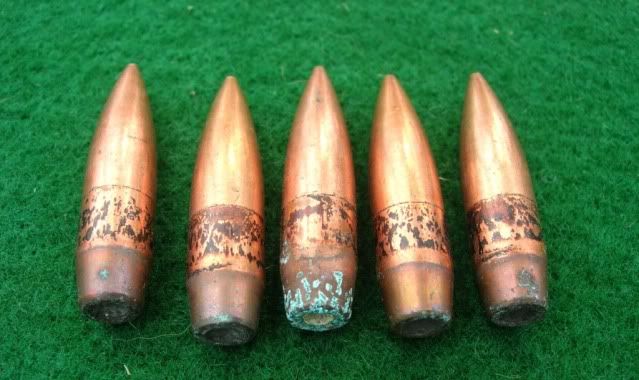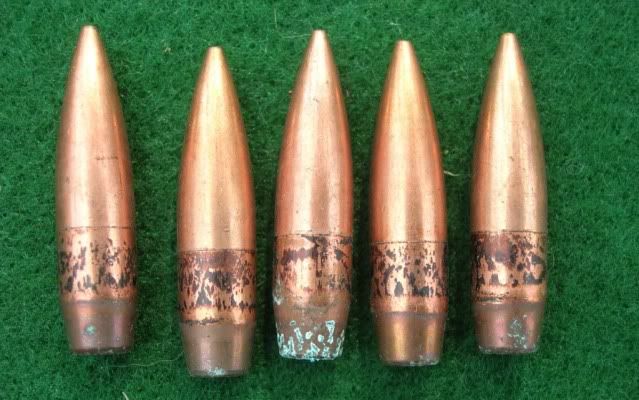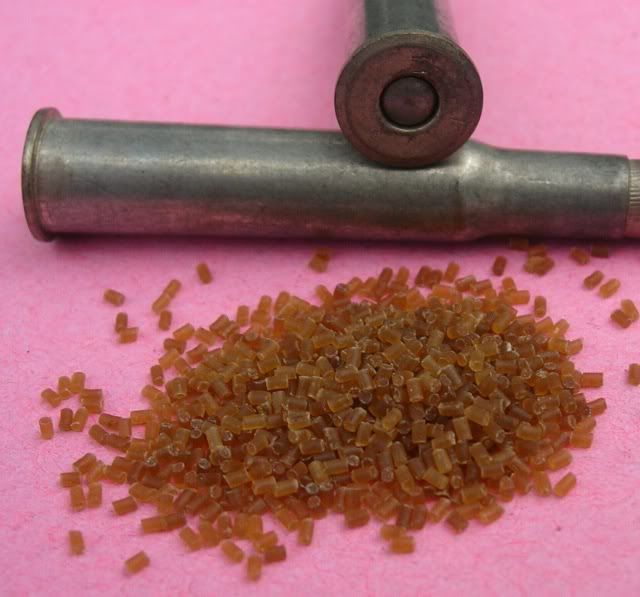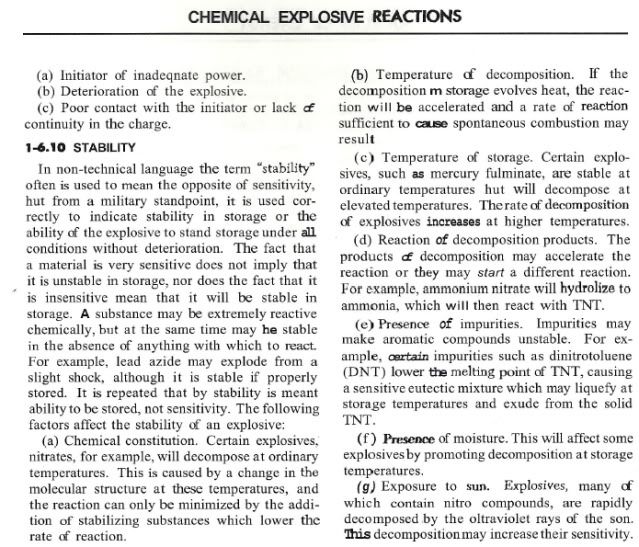
 |
|
|||||||
| Forum Rules | Firearms Safety | Firearms Photos | Links | Library | Lost Password | Email Changes |
| Register | FAQ | Calendar | Today's Posts | Search |
 |
|
|
Thread Tools | Search this Thread |
|
|
#1 |
|
Junior Member
Join Date: November 27, 2011
Posts: 2
|
Using old powders, circa 1980
Hello all, my first post here. Getting my reloading equipment out after about a 30 year hiatus. Boy, that makes me sound old. Equipment has been properly stored and is in good shape. I have about 10 pounds of various powders. I remember that powder properly stored should have an indefinite life. What do you all think? Would this powder be good to go?
|
|
|
|
|
#2 |
|
Senior Member
Join Date: May 25, 1999
Location: Too close to Houston
Posts: 4,196
|
Welcome to The Firing Line!
Properly stored, powder will last a very long time but not indefinately. If your powder smells normal and doesn't show any red dust when poured from one container to another it's probably okay. I had some 1982 vintage IMR 4320 go bad so do check before you use the stuff.
__________________
Proud member of the NRA and Texas State Rifle Association. Registered and active voter. |
|
|
|
|
#3 |
|
Senior Member
Join Date: November 30, 2004
Location: God's side of Washington State
Posts: 1,601
|
Yes Sport 45 hit it on the head. Brown dust and odd smell. Every time I smell powder it reminds me of ether.
__________________
God Bless our Troops especially our Snipers. |
|
|
|
|
#4 |
|
Senior Member
Join Date: May 4, 2010
Posts: 5,468
|
a sign of deteriorating powder is acidic or vinegar smell.
Ether is a good way to describe the smell. The stuff is plastic, and you should smell just that. a plastic, ether, chemical smell, nothing that smells of acids or other sort of stench. OTOH, unless you're really attached to the stuff, I'd probably start fresh. |
|
|
|
|
#5 |
|
Senior Member
Join Date: August 8, 2009
Location: reno, Nv.
Posts: 109
|
I havr a 8 lb can of sr4356. been shoot-in it for a while now. it's maybe 16 year's old. still work's fine. If it was bad, it would get a lot stronger. usually because of being hot.
|
|
|
|
|
#6 |
|
Senior Member
Join Date: April 23, 2008
Location: Medina, Ohio
Posts: 273
|
OP Welcome to the forum. I'm using powders from the 80's, still work for me.
__________________
God Bless America US Army, NRA Endowment TSRA Life, SASS |
|
|
|
|
#7 |
|
Senior Member
Join Date: April 20, 2010
Posts: 275
|
There are a few people still shooting WWII surplus powder. Some people have had powder go bad in a decade or 2.
The advice on smelling and looking for red rusty looking dust is the standard for assessing powder condition. |
|
|
|
|
#8 |
|
Junior member
Join Date: September 27, 2011
Posts: 382
|
1980's powder ?? heck, to me that is NEW powder
 i was using some IMR 3031 to load some Winchester 30-30's that i bought around 1965ad. i was using some IMR 3031 to load some Winchester 30-30's that i bought around 1965ad. 
|
|
|
|
|
#9 | |
|
Senior Member
Join Date: December 29, 2004
Posts: 3,351
|
Quote:
|
|
|
|
|
|
#10 |
|
Senior Member
Join Date: April 7, 2010
Posts: 330
|
Properly stored is the word. And double-based powders are said to be particularly long-lived if that happens to be your case.
|
|
|
|
|
#11 |
|
Senior Member
Join Date: September 27, 2004
Posts: 4,811
|
As long as you use load data from the same time you should be fine. Powders get "tweaked" sometimes & later manuals may reflect the tweak, (among other things) but ones form that time should be dead on for that powder.
__________________
Allan Quatermain: “Automatic rifles. Who in God's name has automatic rifles”? Elderly Hunter: “That's dashed unsporting. Probably Belgium.” 
|
|
|
|
|
#12 |
|
Senior Member
Join Date: June 25, 2009
Location: Stuttgart, AR
Posts: 1,569
|
Smell and inspect as previously posted.
I was tickled pink when a coworker dropped off a barely used can of Winchester 231 a few months ago. I think it’s been a while since powder was sold in a can - particularly a 3 pound can. His best guess was the powder was vintage ‘80s. A couple of pinches plus a match resulted in a “poof,” so I worked up the loads, tested and have been banging away with the old stuff.
__________________
A lack of planning on your part does not necessarily constitute an emergency on my part. |
|
|
|
|
#13 |
|
Senior Member
Join Date: February 10, 2010
Posts: 720
|
Still have a good bit of 1980's powder and remington primers. Some may be from the 1970's. As long as its stored properly, I wouldnt have any problem with it. Keep in mind these primers and powder my Dad bought years ago, so I know how it has been stored and have confidence in it. I might would second guess some unknown storage conditions if the packaging didnt look right.
I have never had any problems with it, just keep in mind loading tables change over the years so keep that in the back of your mind when you decide on a load |
|
|
|
|
#14 |
|
Senior Member
Join Date: May 29, 2011
Location: Fort Worth
Posts: 500
|
I posted essentially the same question a year or so ago on another forum. Except mine is about 40 years old (early 1970s.) Got about the same answers as you are getting.
I have about 20 cans of various powders (mostly rifle) from those days. Some of the tops of the cans have rusted through, and I will eventually dispose of the contents, Most appear OK. Also have a 4# canister of Unique that had been opened, but very little used. Looked and smelled OK. I loaded a half dozen moderate loads for my Redhawk .41 Mag and fed them into the cylinder and fired them one at a time. No problems. Since then I have loaded 9mm, .357, .45 ACP, and .45 Colt, as well as more .41's. All went BOOM and spit the bullet out approximately where I aimed!!!  I have also shot up most of my loaded handgun rounds from those days. No problems with any except the .357's. They were in nickel cases and most of the cases split lengthwise when they were fired in my Colt Trooper MkIII. Didn't realize it until after I had fired them.
__________________
Education teaches you the rules, experience teaches you the exceptions (Plagiarized from Claude Clay) |
|
|
|
|
#15 |
|
Senior Member
Join Date: May 27, 2007
Posts: 5,261
|
Blackpowder has an indefinite shelf life, smokeless does not.
It is a law of nature that things want to go to their lowest energy level and highest entropy. Gunpowder follows the rules of nature. Whether powder is good is not easily answered unless the powder has gross indications of going bad. The gross indications are the bitter smell due to NOx, red powder granules, fuming gas emissions, others have said “red gas”. By the time you see this the powder went bad a long time before. Half of all the surplus IMR 4895 I purchased went bad. The first 16 lbs, I used up eight pounds quickly. For whatever reason, I pulled the bullets on some of that stuff and found green corrosion on the bases of the bullets. Similar to these pull down bullets from old US ammunition. Not the horrible one, but the small green spots.   I don't remember what US ammunition these came off, I pulled them decades ago, might have been WWII ammunition that came back from China. The last eight pounds, it sat around. When I opened the bottle top, it smelled bitter. Red dust flew around. I gave it to a machine gunner guy. He put it in the laundry room. Passing by the laundry room he tossed soiled shorts at the hamper, but missed. The short ended up on top of the powder bottle. Overnight, acid gas from the bottle ate holes in the shorts!!  This freaked my friend and he poured the stuff out over his lawn. This freaked my friend and he poured the stuff out over his lawn.Since then I have had more surplus 4895 powder from a different vendor go bad in the case. Green corrosion on the bottom of the bullets and cracked case necks. This powder never smelt bitter at all. I shot this powder in highpower matches and it shot exceptionally well, but case necks cracked after firing. I also received “funny” retorts and the occasional sticky extraction. The longer the ammunition sat around the more cases necks would split when fired. In time virtually all of the remaining 700 loaded cases experienced cracked case necks without the stresses of firing. From what I had read on the internet, which is a repeat of what is said in gun magazines, powder has an “indefinite” shelf life. Remember reading statements to the effect that powder lost energy as it got old, making it essentially benign. Then I ran into an Insensitive Munitions expert. This IM expert explained that powder deteriorates from the day it leaves the factory. Nitrocellulose decomposes through the reduction-oxidation process. Called Redox. The expert said “The molecular stability of the functional groups on the organic chain determine the life time of the nitrocellulose molecule.” All ionic compounds, water is the main offender because it is always in air, react with those bonds and accelerates the deterioration of the powder. The bottom line is that nitrocellulose is a high energy molecule that wants to become a low energy molecule. Heat accelerates the deterioration/decomposition of powder and the rate is directly proportional to the Arrhenius equation. If you read in the Insensitive munitions literature, you will see that they use high temperature to accelerate aging of smokeless propellants. Double based powders have a reduced lifetime compared with single base. Double based powders have nitroglycerin (NG) in the grain. Nitroglycerine remains a liquid and it migrates within the grain to react with the NO bonds on the nitrocellulose, increasing the rate of reduction-oxidation reaction. All ionic compounds react with those bonds and accelerate the deterioration of the powder. Rust is bad as ferric oxide is ionic. Water is ionic and it is ever present in the air. Because water reacts in a negative way with smokeless propellants, quality ammunition is manufactured in humidity controlled environments. Between 40% and 20% humidity. They don't go lower due to electro static discharge concerns. The best storage condition for powders is arctic. Cold and dry. Due to the migration of NG within double based powders, the surface of the grain will become rich in NG even though the total energy content of the propellant has decreased. This will cause changes in the burn rate, and can cause pressures to spike. The surface of nitrocellulose powders also change as the powder deteriorates, and it changes unevenly. This creates conditions for erratic burn rates. Burn rate instability is undesirable and can cause explosive conditions in firearms. In retrospect, this explains the “funny” retorts I experienced and the sticking cases. It is an extremely rare occurrence, but old ammunition has caused rifle Kabooms. When I discussed this with a machine gunner buddy, he said that explained the two top cover explosions he had with old Yugoslavian 8 MM ammo. I think it explains the Garand kaboom in the link below. NOx gas is a mix of compounds all of which are reactive. http://en.wikipedia.org/wiki/NOx http://en.wikipedia.org/wiki/Nitrogen_oxide When smokeless propellants break down NOx gas is released. Nitric acid gas is only produced in the presence of water, because it requires a hydronimun ion, but there is plenty of water in air. Section from the Propellant Management Guide: Stabilizers are chemical ingredients added to propellant at time of manufacture to decrease the rate of propellant degradation and reduce the probability of auto ignition during its expected useful life. As nitrocellulose-based propellants decompose, they release nitrogen oxides. If the nitrogen oxides are left free to react in the propellant, they can react with the nitrate ester, causing further decomposition and additional release of nitrogen oxides. The reaction between the nitrate ester and the nitrogen oxides is exothermic (i.e., the reaction produces heat). Heat increases the rate of propellant decomposition. More importantly, the exothermic nature of the reaction creates a problem if sufficient heat is generated to initiate combustion. Chemical additives, referred to as stabilizers, are added to propellant formulations to react with free nitrogen oxides to prevent their attack on the nitrate esters in the propellant. The stabilizers are scavengers that act rather like sponges, and once they become “saturated” they are no longer able to remove nitrogen oxides from the propellant. Self-heating of the propellant can occur unabated at the “saturation” point without the ameliorating effect of the stabilizer. Once begun, the self-heating may become sufficient to cause auto ignition. The Armed Forces have stockpile surveillance programs but each Service does theirs a little differently. If you want to see all the different tests the military uses to determine propellant characteristics, look at Mils Std 286 Propellants, Solid: Sampling, Examination and Testing to be found at https://assist.daps.dla.mil/quicksearch/. If you look, you will find aging tests. One common test is for powder to be kept at 65 C until it fumes. It if fumes within 30 days it is checked for stabilizer or scrapped. The Navy expert told me a few ways the Navy samples its powders and propellants. If the powder is outgassing nitric gas (as determined by change of color of methly violet paper in contact with the powder (Methly Violet test, or Talliani test)), the stuff is tested to see how much stabilizer is left. If the amount is less than or equal to 20%, the lot is scrapped. Scrapping powders and propellants with this percentage of stabilizer appears to be consistent across all services. Pages 5-11 of the 2003 Army Logistics Propellant Management Guide provide the protocols for testing and subsequent actions for their Stockpile Propellant Program. Basically, all propellant lots are tracked. The trigger for investigation is: "When Master Sample Stability Failure Occurs" The Navy expert provided 'rules of thumb' concerning when to expect problems with double based and single based propellants. The rules of thumb are: Double based powders and ammunition are scrapped at 20 years, single based 45 years. In his words “These 'rules of thumb' are particularly useful when the protocol fails. The protocol can easily fail when workmanship or good housekeeping measures are not followed during manufacture of propellant and/or rocket motor or during storage of the weapon system components, respectively.” The expert suggested that it is likely that surplus military powders are not on the market anymore due to liability issues. The stuff was scrapped because the military decided it was not safe to keep around anymore. For the home reloader, if the powder has turned red, or smells like acid, it is way beyond its safe limits. I am of the opinion that the reason this is not discussed in the popular gun press is because if the shooting community knew that powders had a shelf life, it might effect sales. As we all know, gunwriters are shills for the industry and for decades the shills have been reassuring us that as powder gets old, it becomes benign. I cannot see a reason why industry wants you, the shooter, to be picky about old powders and old ammunition. You might not buy, you might have reservations about buying. It is all about profits you know. The military does not talk about this, but bunkers and ammunition storage areas have gone Kaboom due to old powder. That nitric acid builds up, creates heat, and the stuff blows up. It blows up inside the case or the shell. http://www.liveleak.com/view?i=13c_1205681217 This powder is from a FA 11-1898 30-40 Krag cartridge. Obviously it is bad.   I sent the IM expert the link with this Garand blowup, http://www.socnet.com/showthread.php?p=1344088 and the pictures of my corroded bullets and pulled Krag red powder, and this is what he wrote back: Wow The red color indicates that the stabilizer is depleted and the redox reaction is degrading the nitrate ester. (I assume this is a single base gun propellant, and the nitrate ester is NC.) Please dispose of this powder and ammo supply before it starts to get warm or self-heat (via autocatalytic exothermic reaction). This stuff can be a runaway reaction and spotaneously explode in storage. The cracked case necks are proof that the outgassing of NOx is occurring. The pressure build-up is evidently enough to fatigue the metal at a high stress location in the cartridge case (@ the neck bend). You should also see a bulge in the cartridge base (where the firing pin would strike b/c there is a circular joint crimp there between the two metals). This ammo would explosively vent at the crack if you tried to fire it in a gun. Just like the Garand example you sent. Please discard this ammo. The corroded ammo is the same as above (redox reaction gassing NOx) except this stuff actually got wet too. Water provides a medium for corrosive acid reactions to result. Please discard this ammo. Lessons learned - (1) Ammo has a finite shelf life (2) Ammo can be dangerous The Garand blowup is interesting as it validates the warning the IM expert told me about old gunpowders. Powder should burn nice and evenly. Old powder that has unevenly aged powder grains can have combustion instability. A machine gunner whom I talked to on this subject told me he had blown the top cover off his machine guns twice using 50's 8mm Yugo surplus. Their are reasons old ammunition was surplused. More to read if you wish: www.dtic.mil/dticasd/sbir/sbir031/n154.doc This paper discusses most of what I have written, but it has a confusing section where it states that “Suddenly, propellant that has spent its entire life in a configuration that was considered inherently safe from the risk of auto ignition is now bulk packaged and stored in a concentrated mass that may be sufficient to allow auto ignition to occur.” After discussions with the Navy expert I found that the insensitive munitions community has its own myths and legends. There are groups within the IM community who promote the “5 inch” rule. The theory is that for munitions 5 inch and smaller, the thermal mass of the case is sufficient to wick away heat and prevent auto ignition. The Navy expert considers this theory to be bogus and created by self serving individuals who get cash awards when they “extend the shelf life” of propellants. Never doubt the power of greed. http://www.almc.army.mil/alog/issues...t_stab_eq.html An picture of powder that went bad in the can is in this thread. http://thefiringline.com/forums/show...04#post4702804  I was told that around 1875-1885 smokeless propellants started stabilizers. These stabilizers using the same species (aniline?) of stabilizers we have today. Today’s stabilizers are improved but the improvement has not doubled or tripled the shelf life of ammunition. Ethyl centralite is still being used as a stabilizer. http://en.wikipedia.org/wiki/Centralite Resinall is a http://www.resinall.com/ plasticizer used in propellants. Stabilizers are the same between ball and stick powders.
__________________
If I'm not shooting, I'm reloading. |
|
|
|
|
#16 |
|
Junior Member
Join Date: November 27, 2011
Posts: 2
|
Wow! Thank you all for the great information. Very much appreciated.
|
|
|
 |
|
|